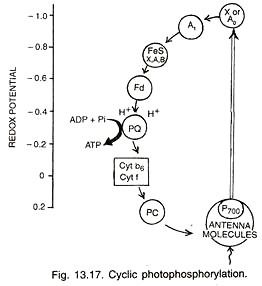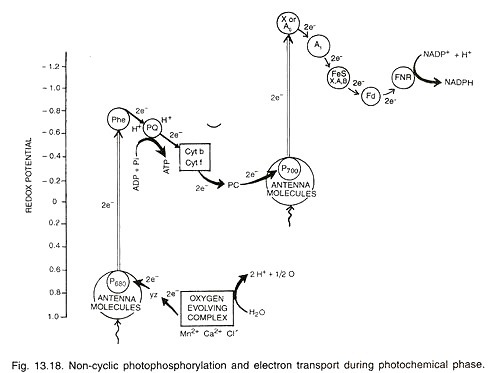ADVERTISEMENTS:
The following points highlight the two types of Photophosphorylation. The types are: 1. Cyclic Photophosphorylation and 2. Non-Cyclic Photophosphorylation.
Type # 1. Cyclic Photophosphorylation:
It is a process of photophosphorylation in which an electron expelled by the excited photo-centre is returned to it after passing through a series of electron carriers. It occurs under conditions of low light intensity, wavelength longer than 680 nm and when CO2 fixation is inhibited.
ADVERTISEMENTS:
Absence of CO2 fixation results in non-requirement of electrons for formation of NADPH. Cyclic photophosphorylation is performed by photosystem I only. Its photo-centre P700 extrudes an electron with a gain of 23 kcal/mole of energy after absorbing a photon of light (hv). After losing the electron the photo-centre becomes oxidized.
The expelled electron passes through a series of carriers including X or A0 (a special P700 chlorophyll molecule), A, (a quinone), FeS complexes (FeSX, FeSA, FeSB), ferredoxin, (Fd), plastoquinone (PQ), cytochrome b – f complex and plastocyanin before returning to photo Centre. While over the cytochrome complex, the electron energises passage of protons to create a proton gradient for synthesis of ATP from ADP and inorganic phosphate.
Halo bacteria or halophile bacteria also perform photophosphorylation but ATP thus produced is not used in synthesis of food. These bacteria possess purple pigment bacteriorhodopsin attached to plasma membrane. As light falls on the pigment, it creates a proton pump which is used in ATP synthesis.
Type # 2. Non-Cyclic Photophosphorylation:
ADVERTISEMENTS:
It is the normal process of photophosphorylation in which the electron expelled by the excited photo-centre does not return to it. Non-cyclic photophosphorylation is carried out in collaboration of both photosystems I and II. Electron released during photolysis of water is picked up by photo-centre of PS II called P680. The same is extruded out when the photo Centre absorbs light energy (hv).
The extruded electron has an energy equivalent to 23 kcal/mole. It passes through a series of electron carriers— phaeophytin, PQ, cytochrome b – f complex and plastocyanin. While passing over cytochrome complex, the electron loses sufficient energy for the synthesis of ATP. The electron is handed over to photo Centre P700 of PS I by plastocyanin. P700 extrudes the electron after absorbing light energy. The extruded electron passes through special chlorophyll X, Fe-S, ferredoxin, to finally reach NADP+. The latter then combines with H+ (released during photolysis) with the help of NADP-reductase to form NADPH. This is called Z scheme due to its characteristic zig-zag shape based on redox potential of different electron carriers (Fig. 13.18).


